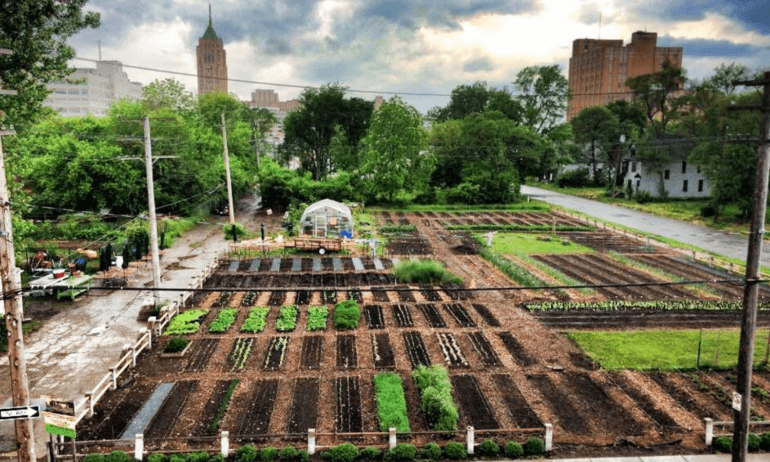Little Known Facts About City Blooming.
Little Known Facts About City Blooming.
Blog Article
Excitement About City Blooming
Table of ContentsIndicators on City Blooming You Should KnowExcitement About City BloomingFacts About City Blooming RevealedSome Known Factual Statements About City Blooming Some Known Incorrect Statements About City Blooming

As you walk the streets of the Bronx, Southside Chicago or East Oakland, you might see have also seen big plots of ripening fruits and veggies being harvested. What exactly are city farms and community yards? Urban farming, metropolitan farming, or urban horticulture is the technique of cultivating, handling and distributing food in or around metropolitan areas.
Usually, metropolitan farming as a technique is a larger investment than horticulture. There are many extra hours spent right into the minutiae of farming, from the plant plan to the often tending of your beds. This moment dedication takes on an entire new significance once you realize the goal that is being functioned in the direction of and committed, particularly that of obtaining a plentiful return of crops to be eaten.
A neighborhood garden is a single tract gardened jointly by a group of people. Community gardens utilize either individual or shared plots on personal or public land while creating fruit, vegetables, and/or plants grown for their appealing appearance. The fundamental version here is that a big group of individuals each add a relatively little amount of time to working their own story, and obtain the fruits of their labor as an outcome.
City Blooming - Questions

, and area companies by assisting them establish and grow their own yards. The distinctions in between neighborhood garden and urban ranch are nuanced, though in the end the very same standard task takes placefood plant cultivation however within various business frameworks - garden care.
Urban ranches are usually much more business and technology oriented, with the key objective of taking full advantage of returns and selling produce. Industrial urban ranches are often focused on expanding manufacturing on generally little acreage with technologies in modern technologies such as tank farming, hydroponics, and greenhouses and might companion with a commercial kitchen area to create locally-produced value-added items such as jams and sauces.
The 7-Minute Rule for City Blooming
The produce is generally expanded on a much smaller scale and is taken home to consume at home or to share. By supplying much needed eco-friendly areas in penniless, concrete metropolitan areas, they enable the advantages of backyard horticulture to those lacking yards, and work as excellent examples of self-organization and community activism.
Some community yards, typically in metropolitan areas, relocate into expanding for industrial usage while some city ranches open up their land for more socially aware advantages. Regardless of how you define and separate the two, they are both positive forces for good in cities around America and the globe.
As all of Tiny Axe Peppers' hot sauces are sourced with peppers from neighborhood gardens, your purchases directly aid fund these neighborhood projects (https://www.openlearning.com/u/danielnold-sfprdq/). Take component in the revolution by.
A friend of mine just recently commented in a discussion about gardening that "It's interesting, I've always thought that farming as a technique is rather like horticulture. There are comparable aspects to both do not you believe?" To the layman that remark from my close friend would certainly have do without much idea, it appears sensible so why not take it thus? As I invested even more and more time in my Urban Farming class I've come to realize that to state that gardening is a mini expansion of agriculture would be a little bit of stretch.
The Ultimate Guide To City Blooming
They both focus on the care of plants for some goal that can be nourishment, earnings or just the satisfaction of the craft. Moreover they both need a monetary financial investment on top of a time investment, something that a great deal of people in our rapid paced life do not have a go to this website whole lot of - urban gardening.
We can see that the similarities are bountiful, however are the distinctions enough to produce a distinction? As a student at NYU I have the opportunity to function with the leave It Much better Foundation, a group that shows fundamental nourishment and gardening to high college students. https://businesslistingplus.com/profile/cityblooming/. This experience offered me an extensive foray right into the world of amateur horticulture beyond what most individuals have been in call with
Farming as a method is a bigger financial investment than gardening. There are countless more hours spent into the trivial matters of farming, from the plant plan to the often tending of your beds.
The typical gardener tackles his obligations as a duty instead of a requirement and thus differentiates his or herself from the farmer. With this difference in hand, they are both soothing and soothing workouts that any person can pick up, which by itself must be an ad for both.
Facts About City Blooming Revealed
Something failed - eco-friendly practices. Wait a minute and attempt once more Attempt again
Report this page